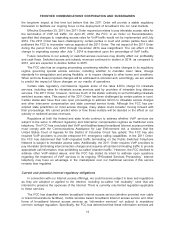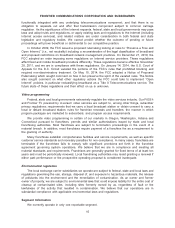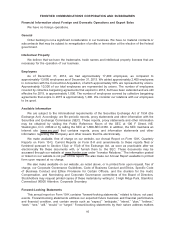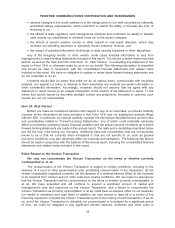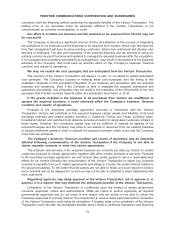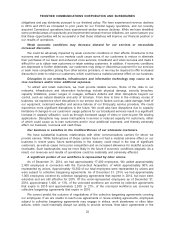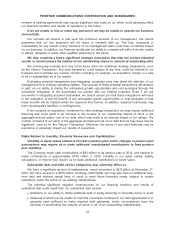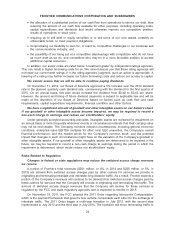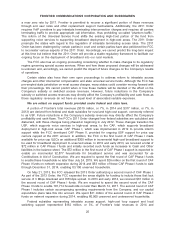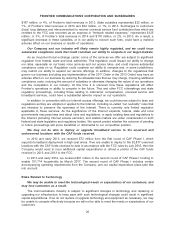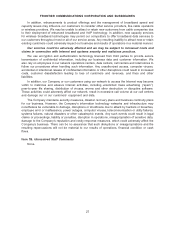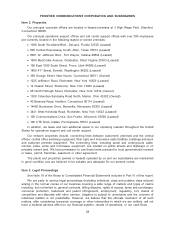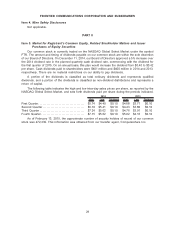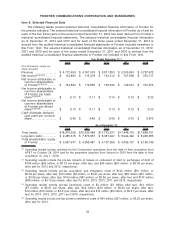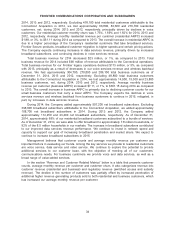Frontier Communications 2014 Annual Report Download - page 25
Download and view the complete annual report
Please find page 25 of the 2014 Frontier Communications annual report below. You can navigate through the pages in the report by either clicking on the pages listed below, or by using the keyword search tool below to find specific information within the annual report.•the allocation of a substantial portion of our cash flow from operations to service our debt, thus
reducing the amount of our cash flow available for other purposes, including operating costs,
capital expenditures and dividends that would otherwise improve our competitive position,
results of operations or stock price;
•requiring us to sell debt or equity securities or to sell some of our core assets, possibly on
unfavorable terms, to meet payment obligations;
•compromising our flexibility to plan for, or react to, competitive challenges in our business and
the communications industry; and
•the possibility of our being put at a competitive disadvantage with competitors who do not have
as much debt as we do, and competitors who may be in a more favorable position to access
additional capital resources.
In addition, our senior notes are rated below “investment grade” by independent ratings agencies.
This can result in higher borrowing costs for us. We cannot assure you that these rating agencies will
not lower our current debt ratings, if in the rating agencies’ judgment, such an action is appropriate. A
lowering of a rating may further increase our future borrowing costs and reduce our access to capital.
We cannot assure that we will be able to continue paying dividends.
On December 11, 2014, our Board of Directors approved a 5% increase over the 2014 dividend
rate in the planned quarterly cash dividend rate, commencing with the dividend for the first quarter of
2015. On an annual basis, this plan would increase the dividend from $0.40 to $0.42 per share.
However, the amount and timing of future dividend payments is subject to applicable law and will be
made at the discretion of our Board of Directors based on factors such as cash flow and cash
requirements, capital expenditure requirements, financial condition and other factors.
We have a significant amount of goodwill and other intangible assets on our balance sheet.
If our goodwill or other intangible assets become impaired, we may be required to record a
non-cash charge to earnings and reduce our stockholders’ equity.
Under generally accepted accounting principles, intangible assets are reviewed for impairment on
an annual basis or more frequently whenever events or circumstances indicate that their carrying value
may not be recoverable. The Company monitors relevant circumstances, including general economic
conditions, enterprise value EBITDA multiples for other rural ILEC properties, the Company’s overall
financial performance, and the market prices for the Company’s common stock, and the potential
impact that changes in such circumstances might have on the valuation of the Company’s goodwill or
other intangible assets. If our goodwill or other intangible assets are determined to be impaired in the
future, we may be required to record a non-cash charge to earnings during the period in which the
impairment is determined, which would reduce our stockholders’ equity.
Risks Related to Regulation
Changes in federal or state regulations may reduce the switched access charge revenues
we receive.
A portion of Frontier’s total revenues ($201 million, or 4%, in 2014 and $235 million, or 5%, in
2013) are derived from switched access charges paid by other carriers for services we provide in
originating and terminating intrastate and interstate long distance traffic. As a result, Frontier expects a
portion of the Company’s revenues will continue to be derived from switched access charges paid by
these carriers for services that the Company will provide in originating and terminating this traffic. The
amount of switched access charge revenues that the Company will receive for these services is
regulated by the FCC and state regulatory agencies and is expected to decline in 2015.
On November 18, 2011, the FCC adopted the 2011 Order regarding Intercarrier Compensation,
which is the payment framework that governs how carriers compensate each other for the exchange of
interstate traffic. The 2011 Order began a multi-year transition in July 2012, with the second step
implemented in July 2013 and the third step in July 2014. The transition will move terminating traffic to
24
FRONTIER COMMUNICATIONS CORPORATION AND SUBSIDIARIES


